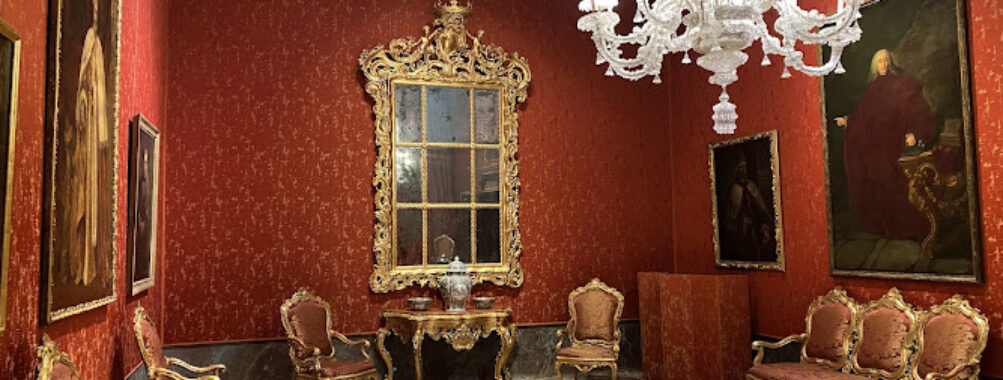
Mocenigo Palace-Museum
Table of Contents
Description
The Mocenigo Palace-Museum in Venice feels like stepping into a time capsule, one that still smells faintly of history, perfume, and wood polish. This 17th-century palace once belonged to the Mocenigo family, one of Venice’s most influential dynasties, with seven doges to their name. Today, the building has been transformed into a museum that tells stories of fashion, textiles, and the art of perfume, while still keeping that lived-in, aristocratic aura. It’s not one of those sterile museums where everything feels too polished and untouchable—here, you get the sense that people actually lived, entertained, and schemed in these rooms. And honestly, that’s what makes it so captivating.
The palace itself is grand but not overwhelming. You’ll find frescoed ceilings, rococo furniture, and rich fabrics that whisper of 18th-century elegance. The costume and textile displays are especially fascinating, showcasing how Venetians dressed to impress long before Instagram made it a thing. Then there’s the perfume section, which might just be the highlight for many visitors. It’s not only about bottles and labels; it’s about the alchemy of scent, the way Venice became a hub for exotic spices and essences, and how fragrance was woven into daily life. You can even experiment with interactive exhibits that let you explore different notes and blends.
Of course, not every visitor walks away in awe. Some find the museum smaller than expected or wish there was more detail in the exhibits. But others rave about its charm, the quiet atmosphere, and the fact that it’s less crowded than Venice’s blockbuster attractions. Personally, I think that’s part of the appeal—you can wander at your own pace without being herded through like cattle. It’s a place that rewards curiosity, and if you’re the kind of traveler who enjoys peeling back layers of history, it’s worth your time.
Key Features
- Lavishly decorated rooms with original frescoes and rococo furnishings
- Extensive collection of 18th-century Venetian costumes and textiles
- Dedicated perfume section exploring the history and craft of fragrance
- Interactive exhibits that engage your senses, especially smell
- Authentic aristocratic atmosphere that feels less “museum” and more “home”
- Wheelchair accessible restroom, though parking is limited nearby
- Family-friendly environment, making it a manageable stop with kids
Best Time to Visit
Venice is one of those cities that never really has an “off” season, but timing can make a huge difference in how you experience the Mocenigo Palace-Museum. Spring and autumn are my personal favorites—the weather is comfortable, and the city feels alive without being unbearably crowded. Summer can be tricky: yes, the long days are perfect for sightseeing, but the heat and humidity inside old palaces can feel stifling. Winter, on the other hand, has its own charm. Imagine walking through these grand rooms while the canals outside are quiet and misty—it feels almost cinematic. And if you’re in Venice during Carnival, the costume displays suddenly make even more sense, like puzzle pieces clicking into place.
How to Get There
Getting to the Mocenigo Palace-Museum is straightforward once you’ve figured out Venice’s labyrinth of canals and alleys. The palace is located in the San Stae area, not far from the Grand Canal. If you’re taking a vaporetto, hop off at the San Stae stop—it’s just a short walk from there. For those who enjoy wandering, you can also reach it on foot from Rialto or Santa Lucia station, though be prepared for plenty of bridges and twists along the way. Honestly, half the fun is getting a little lost and stumbling across quiet courtyards and hidden canals. Just remember to give yourself extra time; Venice is notorious for turning a “10-minute walk” into a 30-minute adventure.
Tips for Visiting
Here’s the thing about the Mocenigo Palace-Museum: it rewards visitors who slow down. Don’t rush through it like you’re ticking off a checklist. Take your time to look up at the ceilings, notice the tiny details in the embroidery, and actually breathe in the perfume displays. If you’re traveling with kids, the interactive scent exhibits can keep them engaged, which is a lifesaver in a city where most museums aren’t exactly child-friendly.
I’d also suggest visiting earlier in the day. It’s never as crowded as the Doge’s Palace or St. Mark’s Basilica, but mornings tend to be quieter, giving you space to really enjoy the atmosphere. Wear comfortable shoes—yes, it’s a palace, but you’ll still be on your feet quite a bit. And don’t expect a café or restaurant inside; grab a coffee or snack beforehand at one of the nearby bars.
Accessibility-wise, the museum does have a wheelchair accessible restroom, which is a plus, though parking is practically non-existent in this part of Venice (as is the case everywhere in the city). If mobility is a concern, plan your route carefully and use the vaporetto stop nearby.
Lastly, don’t skip the perfume section, even if you think you’re not “into” scents. It’s surprisingly engaging and gives you a whole new perspective on how Venetians lived. I remember fiddling with one of the interactive displays and suddenly realizing how much a single fragrance could tell you about trade, culture, and even status. It’s those little moments that make the visit memorable.
So, if you’re looking for a museum that’s a little off the beaten path but still packed with history, beauty, and a touch of sensory magic, the Mocenigo Palace-Museum is a solid choice. It may not dazzle everyone in the same way, but for travelers who enjoy peeling back the layers of Venice’s past, it’s a gem worth discovering.
Location
Places to Stay Near Mocenigo Palace-Museum
Find and Book a Tour
Explore More Travel Guides
No reviews found! Be the first to review!